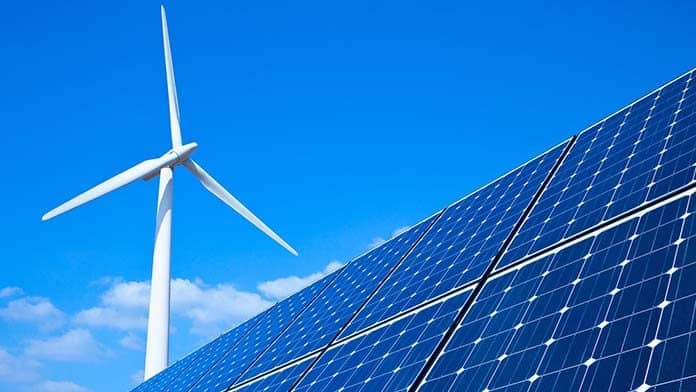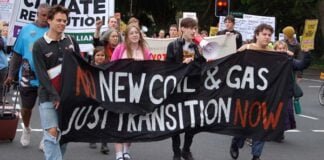Penny Howard argues that public spending and ownership are the only way to ensure a rapid transition to 100 per cent renewable energy—and to protect workers’ jobs
Australia’s electricity sector is our country’s single largest contributor to greenhouse gas emissions at 33 per cent of total emissions. It is also the sector that provides the greatest opportunity for rapid reductions in emissions through the transition to renewable energy.
School climate strikers rightly demand “100 per cent renewable energy by 2030”. But the privatised, fragmented and profit driven nature of the national electricity system is making this transition impossible.
We urgently need to take the production and distribution of electricity back into public hands and fight for massive public investment in renewables. This is the only way to ensure a reliable, clean electricity supply at cheap prices. This can also ensure that workers and communities currently dependent on carbon-intensive energy production have a just transition to jobs in a clean energy future.
Between WWI and WWII, Australian state governments systematically nationalised and expanded electricity supply. By the 1960s Australia had an almost universally publicly owned and controlled electricity system which provided some of the cheapest and most reliable electricity in the world.
This all changed in the 1990s when state-based Electricity Commissions or Trusts were broken up, corporatised, and incorporated into the National Electricity Market (NEM) established in 1998. Energy retailers across the country and grid operators in South Australia and Victoria were then fully privatised, and in NSW privatisation began in 2010.
The NEM was established in the same year the Commonwealth Government signed the Kyoto Protocol. Yet the NEM’s “objectives” and “rules” do not include any consideration of greenhouse gas emissions.
The grid and the NEM are currently run to facilitate market competition and private investment. Electricity prices in this privatised system have become among the world’s highest.
Privatisation and marketisation have meant that the technical oversight and planning of the national electricity network is split into multiple grid operator, generator, and retailing companies—each operating to maximise their own profits. Speculation on price fluctuations is rife, while every player in the game is guaranteed a profit by the market regulator.
There is race to the bottom between energy companies on staffing levels, maintenance costs, and network reliability. Electrical Trades Union (ETU) members have complete safety bans on working in many electricity substations around the country as a result.
Through the many years of privatisation, thousands of skilled maintenance workers have been laid off, and apprenticeship programs reduced or eliminated. Instead, layers of management and marketing and sales departments have been added to chase customers with confusing electricity offers, adding up to $200 to annual electricity bills. Meanwhile, three of the largest companies in the electricity system made a combined $2.6 billion in profit in 2018.
Coal-fired electricity
In the year to September 2019, 70 per cent of electricity supplied to the NEM came from coal-fired power stations, and 9 per cent from gas. There are 23 coal-fired power stations operating in NSW, Qld, Victoria and WA, mostly owned by private companies.
Even though the cost of building new renewable generation is now lower than building new coal-fired power stations, existing stations have already been paid for and are relatively cheap to keep running. Companies will not voluntarily stop operating assets that are still potentially profitable—and in NSW these are stations that companies bought less than seven years ago.
Companies are supposed to give the government three years’ notice of closure—but this requirement is full of loopholes that mean uncertainty about workers’ jobs.
The next coal-fired power station set to close is Liddell in the Hunter Valley, in 2023, then two units of the Muja station in WA between 2022 and 2024. On current estimates 14 coal power stations are still set to be functioning into the 2040s.
If the “transition” to renewables is left to the market, Australia will continue to pump out unacceptable levels of carbon from electricity generation for decades to come.
Renewable energy in Australia
Last year 19 per cent of Australia’s energy came from renewable sources, including both rapidly increasing wind and solar power, and the hydro power stations that have existed for decades in the Snowy Mountains and Tasmania.
Across Europe, renewable energy development in a privatised electricity market was encouraged by on one hand, setting a carbon price, and on the other hand, spending billions on creating investment incentives and reducing risk for private renewable energy developers.
Variations of this model have been exported to North America, Australia, and even China. But this approach has since proven unable to meet the challenge. According to Trade Unions for Energy Democracy, emissions reduction targets are not being met, and by 2015 $150 billion of public money had been spent subsidising a system not under public control.
In Australia, a key policy has been the Renewable Energy Target (RET), which set a target for renewable generation by 2020. It issued tradeable Certificates for companies that produce renewable energy which energy retailers and large users were required to buy. This additional subsidy for renewable energy developers was ultimately subsidised by consumers, who paid an estimated $40 annually to support the RET through energy bills.
Nationally, the Coalition government are winding up the RET. But there are similar RETs in Queensland and Victoria, as well as reverse auctions run by the Queensland, ACT and Victorian governments which effectively guarantee a minimum price for developers.
RETs and reverse auctions have encouraged construction of renewable energy projects, but this has taken place chaotically, without planning where these projects should be located, how they fit into existing energy supply, and what transmission is needed to support them.
In 2018, 38 renewable energy projects were completed owned by 32 different companies. The companies bring in their own contractors for construction, and poor conditions on the worksites are rife. In many cases, licenced electricians are not used and installations do not meet electrical safety standards. Companies must then negotiate the crucial grid connection they need to sell electricity with the company operating the grid locally. This can take years of contractual battles, as both parties seek to reduce their costs as much as possible.
This disorganised system can function at low levels of renewable energy, but as the percentage of renewable energy increases, significant problems are developing.
The conservative dismissal of renewable energy as “intermittent” and their call for “baseload power” is a figleaf for promoting coal and nuclear power. However, it is true that renewable energy supply is variable, and solar energy is concentrated in the middle of the day when the sun is shining.
A renewable energy system requires planning to balance out this variability by using different types of generation, connecting different geographical areas, and by using systems of energy storage such as batteries and pumped hydro to ensure grid stability and that sufficient power is available when needed. The discussions around the cost of renewables that focus on a single project do not incorporate these system-level costs. A system based on 100 per cent renewable energy would look very different to the current grid that was constructed for more large-scale, continuously run coal-fired power.
In an attempt to better plan the electricity system, AEMO developed its first Integrated System Plan (ISP) in 2018, which is now being reviewed and updated. But the ISP is weak and filled with contradictions. It recommends all sorts of new grid interconnectors—but has no power to build them or to require they are built. NSW Minister for Energy and Utilities Don Harwin said that in 2018, only one in 20 proposed new renewable energy projects in the planning pipeline actually have a grid connection available to them.
Instead of systematically planning where projects should be built and the system needed to support them, regulators have added new fees for remote projects to send a “market signal”.
AEMO says four new projects to upgrade and build transmission lines between NSW, Victoria, SA and Qld are critical to maintaining reliability as some coal fired power stations shut and renewables are brought online. It appears that they are mainly relying on Transgrid to do this work. But Transgrid was fully privatised by the NSW Liberal government in 2015, for $10 billion.
In order to encourage a privatised Transgrid to do this work, the NSW government is offering them a “funding guarantee”, the South Australian government has offered to put in over $200 million, and the COAG Energy Council and the Energy Security board are exploring setting up a Fund that could be used to “underwrite” investments recommended by the ISP. In contrast, a public company could just be directed to make this investment, and could access the lowest cost financing available.
Public investment now
We cannot bet the future of humanity and the planet on trying to create enough “incentives” to convince a small number of private investors to build the new renewable energy systems we need.
A rapid transition to 100 per cent renewable energy is going to require taking the electricity system back into public ownership and ensuring it is properly redesigned and rebuilt for renewable energy. In one sense conservatives are right to say that our electricity grid has become more unstable, but of course they won’t admit that it is their marketised energy policy that caused these problems. They would rather see the planet burn that force the public investment and ownership of the system that is needed.
With public ownership and planning, systems could be put in place for workers to transition directly from high-emissions to low-emissions jobs, and ensure jobs in renewables are secure union jobs. The transformation of the energy network could and should provide the investment that regional Australia desperately needs. Many more social and economic transformations will be needed to prevent catastrophic climate change, but this is a key start.






